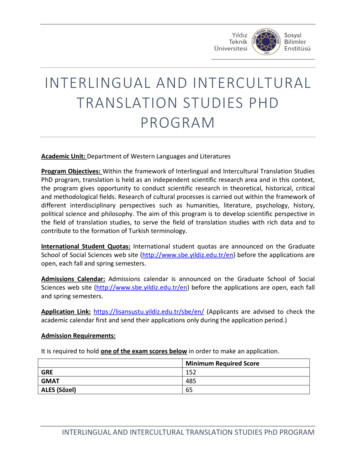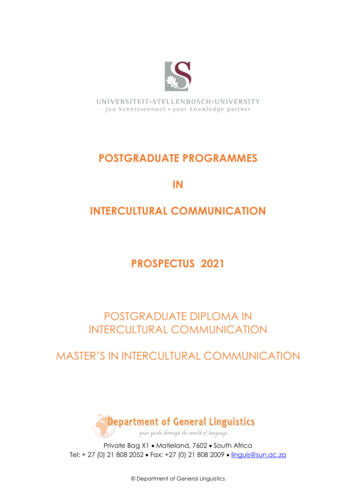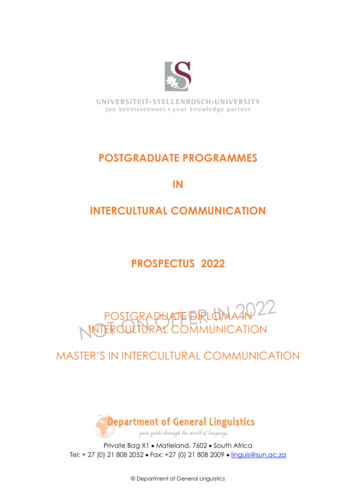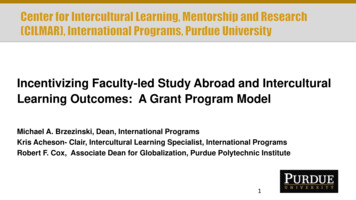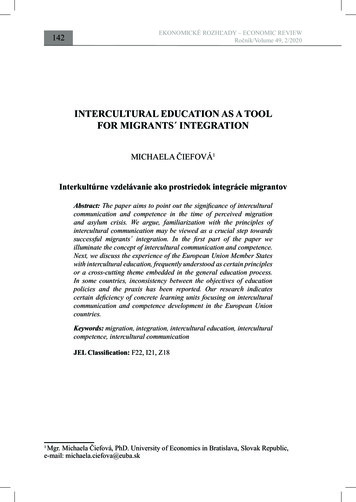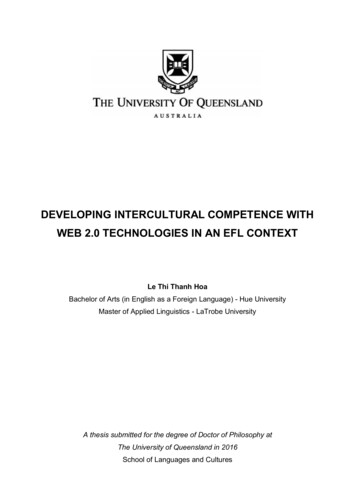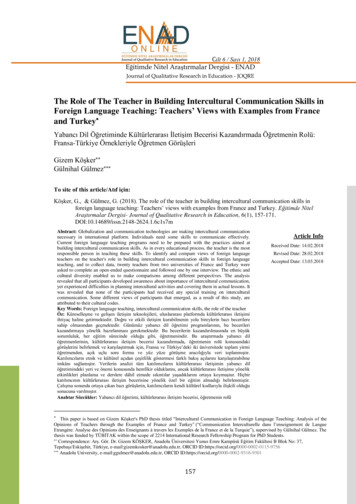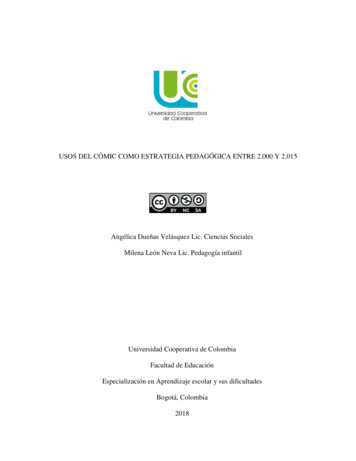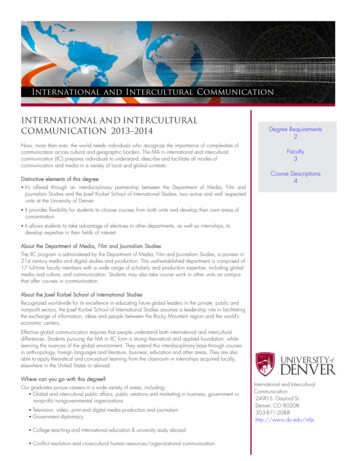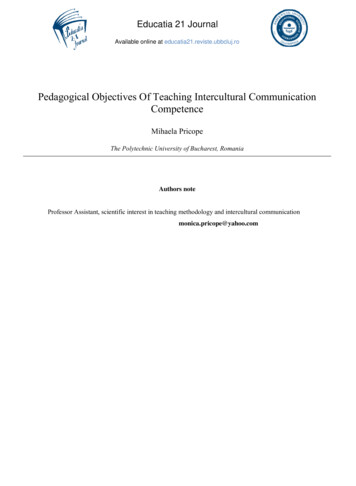
Transcription
Educatia 21 JournalAvailable online at educatia21.reviste.ubbcluj.roPedagogical Objectives Of Teaching Intercultural CommunicationCompetenceMihaela PricopeThe Polytechnic University of Bucharest, RomaniaAuthors noteProfessor Assistant, scientific interest in teaching methodology and intercultural communicationmonica.pricope@yahoo.com
Mihaela PricopeEducatia 2113\2013 Art. #7, pp 54-61AbstractIn the contemporary educational system we can remark a change of paradigm towards active learning andcompetence-based education. However, we should not understand that this is a radical change and that education hasabandoned teaching knowledge in favour of competences. This is impossible, since competences include knowledgein their structure, and teaching has different functions, among which one remains that of transmitting knowledge.The cultural diversity found at educational level is an extraordinary source of progress and innovation regarding theteaching methodology and the academic communication. This diversity should be valued and used as a resource, sothat academic results could appear and, along with them, the student’s/teacher’s satisfaction.This article explores the foreign students’ perceptions regarding what makes effective communication in anintercultural academic environment. The findings show differences according to the culture of origin, which lead usto the conclusion that intercultural communication competence could be built in a multicultural classroom by settingspecific objectives related to comparing cultures and raising students’awareness about the importance of differencesas enriching experience.Keywords: teaching objectives, intercultural communication, foreign studentsZusammenfasungMan bemerkt in dem zeitgenössischen Erziehungssystem eine Paradigmaveränderung zumAktivlernen und Konzentrierung auf Kompetenzen. Man soll trotzdem nicht verstehen, dass es um eineradikale Veränderung geht und der Unterricht die Kenntnisseauslieferung zugunsten von denKompetenzen verlassen hat. Das ist unmöglich, da die Kompetenzen Kenntnis in ihre Struktur beinhalten,und Unterrichten verschiedene Funktionen, darunter auch der Kentnissevermittlung hat. Was diedidaktische Methodologie und die pädagogische Kommunikation und Relation anbetrifft, ist die kulturelleVerschiedenheit in der erzieherischen Umgebung eine außerordentliche Fortschritt- undInnovationsquelle. Das sollte dementsprechend verwertet werden, so dass die akademischen Ergebnissenund zur gleichen Zeit die Studenten- und Professorenzufriedenstellung auftauchen.Dieser Artikel untersucht die Wahrnehmungen der Auslandsstudenten betreffend die wirksameKommunikation in einer interkulturellen akademischen Umgebung. Die Forschungsergebnisse stellen dieVerschiedenheiten im Zusammenhang mit der originellen Kultur dar. Daraus ergibt sich dieSchlussfolgerung, dass für die Bildung einer interkulturellen Kommunikationskompetenz in einer Klassemit kulturellen Verschiedenheiten musste man solche Ziele festsetzen werden, die das Vergleichenverschiedener Kulturen und die Studentenbewusstsein betreffend der Bedeutung der kulturellenVerschiedenheiten als erhebende Erfahrung hinweisen.Schlüsselworte: pädagogische Ziele, interkulturelle Kommunikation, Auslandsstudenten
Mihaela PricopeEducatia 2113\2013 Art. #7, pp 54-61Pedagogical Objectives of Teaching Intercultural CommunicationCompetence1.IntroductionThe introduction of the intercultural element in training could be noticed especially in informaland non-formal educational settings. Still, on the one hand, the simple interaction between internationalstudents in the campus or at school does not implicitly lead to acquiring and developing interculturalcommunication competence. On the other hand, this competence cannot be taught in a formal educationalsetting without the direct contact/interaction with the otherness.Effective communication is always dependent on context and, since culture is part of the context,communication is rarely separate from the cultural element. Thus, we agree that learning a foreignlanguage cannot be separate from learning the target culture. It is important that international studentsshould become aware of their own culture and of the other cultures as well; otherwise, the messages in theforeign language shall be interpreted according to their own cultural framework and this fact could lead tomisinterpretations and ineffective communication.The concept of intercultural communication competence, present in the works of the Council ofEurope, is largely used in teaching modern languages, especially the international ones. The authorMichael Byram (1997), designs a structural model of this competence, made of five cultural elements „savoirs” - and three linguistic ones. The five cultural „savoirs” refer to: attitudes (curiosity, openness,trust in one’s own culture), knowledge, skills of interpreting and relating (skills of interpreting adocument/event from another culture, of explaining it and relating it to other documents/events fromone’s own culture), skills of discovering and interacting (ability to acquire new knowledge regarding aforeign culture and to operate with them), cultural critical awareness (ability to evaluate critically, andbased on explicit criteria one’s own culture and other cultures).We believe that the development of the intercultural communication competence of foreignstudents leads to the improvement of the communication with the teacher and with the intercultural groupof students, to an increased capacity of communicating in the target language and to better adaptation tonew cultures, by coping with culture shock.There are various theoretical models of intercultural communication competence in the literature– linear, dynamic, structural, adaptational, psychological or holistic. We believe that due to thecomplexity of this competence which can be developed during the whole life, by formal, non-formal andinformal education in a complementary way, it can only be view but holistically. That is why, when wetalked about the intercultural speakers’ competences, we opted for a holistic view which compriseslinguistic, cultural, psycho-attitudinal elements, based on the theoretical models of M. Byram, W.Gudykunst, K. Deardoff, but also on the concepts of „intermediary space”/„the third space”/”interculturalspace” (Kramsch 1993, Clanet, 1990 ), or „ cultural implicit” (Clanet, 1990, Colles 1998, Louis, 2009,Zarate 2003).
Mihaela PricopeEducatia 2113\2013 Art. #7, pp 54-61In Romania, the field of intercultural education/communication was researched by authors, forexample: Constantin Cucoş, Teodor Cozma, Anca Nedelcu, Liviu Antonesei, Simona Butnaru, Călin Rus.They approach intercultural education as a strategy at the level of different educational dimensions, forexample, the curriculum, the values promoted by education, the educational climate and the teacherstudent relation, the teaching objectives and the methodology. The recent works of the Council ofEurope, which dedicated numerous pages to teaching and assessing intercultural competence see it as anintegral part of the study of modern languages, since dealing with otherness is one of the most importantteaching objectives in this field.2. Research methodologyThe airm of our research is to adapt the teaching curricula of foreign languages includingRomanian for foreigners to learners’ needs and interests by finding out the foreign students’ perceptionsregarding the factors which promote effective intercultural communication in an academic environmentaccording to their culture of origin.Thus, the teacher could prioritize a set of teaching objectives which better reflects the students’views and perceptions. Our research hypothesis is the following:Hypothesis : The students’ culture of origin, that is the Western (Europe and America) and the NonWestern (the rest of the respondents’cultures of origin) influences their choices regarding various factorswhich promote effective intercultural communication.Our research population consists of foreign students enrolled at Romanian universities indifferent study programmes (Bachelor, Master, PhD) who attend a preparatory year to learn the Romanianlanguage. The study program of the preparatory year is regulated by the Romanian Law and it stipulatesthat the students must attend an intensive language and culture course which should teach them thelanguage from a communicative perspective, including specialized vocabulary and should familiarizethem with the Romanian culture and civilization.In order to maximize learning the target language and the culture at the same time and to facilitatecultural and social adaptation during this course, we propose an intercultural approach to teaching andlearning a foreign language, which is briefly defined as a focus on teaching communication skills in anintercultural environment. This involves immersion in the everyday culture and exposure to authenticteaching materials and experience.The research population was established starting from a list of homogeneous groups - foreignstudents enrolled in the preparatory year and Romanian language teachers - and the qualitative selectionwas made so that it could cover several research variables, required for further interpretation of theresearch data: sex, age, culture of origin, language spoken and age for students and interculturalexperiences.The criteria for inclusion in the study were:- foreign students who study Romanian as a foreign language- willingness to participate in the study
Mihaela PricopeEducatia 2113\2013 Art. #7, pp 54-613. FindingsAs we mentioned above, we are interested in finding out the foreign students’ perceptionsregarding the factors which promote effective intercultural communication in an academic environmentand to see if there are any differences according to their culture of origin.The respondents’ views regarding the following factors which promote effective communicationin an academic environment differ significantly from a statistical point of view according to their culturalorigin:- to be able to understand my interlocutor’s messages from his/her own cultural frame ofreference (f)- to be able to reflect critically on my own experience with persons of different culturalbackgrounds (i)- to be open to other cultures and tolerant before diversity (n)- to be sincere in communication (p)- to be fair with my interlocutor (r)In order to measure how the students’ culture of origin may influence their perceptions regardingthe factors which promote effectice intercultural academic communication we calculated the Pearsoncoefficients, as it results from the table below:Table 1. Pearson values. Correlations cultural origin – factors which promote intercultural communicationOrig studQ3 fPearson Correlation0,147*Sig. (2-tailed)0,043NQ3 iQ3 nQ3 pPearson Correlation190-0,011Sig. (2-tailed),877N189Pearson Correlation0,054Sig. (2-tailed),459N189Pearson Correlation0,216**Sig. (2-tailed),003N189
Mihaela PricopeEducatia 21Q3 rPearson Correlation13\2013 Art. #7, pp 54-610,210**Sig. (2-tailed),004N189The table above presents the existing intermediate level correlations between the items f, p, rfrom the list above and the cultural origin of the foreign students. It’s interesting how the moreimportance is attached to the factors which promote effective intercultural communication: “to be sincerein communication” and „to be fair with my interlocutor” the farther to the West is the foreign students’cultural origin. Thus, the importance given to sincerity and fairness is more significant for the nonWestern respondents than for the Western ones. Furthermore, a Pearson coefficient of 0.14 in the case ofthe item „f” leads us to believe that the importance given to the capacity to understand my interlocutor’smessages from his/her own cultural frame of reference is a more important factor for non-Westerners. Inthis situation, we would have expected a reverse situation because multiculturalism appeared in theWestern societies and is still on the wave.In order to analyse more clearly how the cultural origin influences various factors which promoteeffective intercultural communication acording to the respondents’ views, we ordered the averaged weobtained for each item on groups of respondents coming from different cultural backgrounds.Table 2. Factos which promote effective intercultural communication according to the cultural originOriginOption 1EuropeTo know one or moreinternationallanguagesOption 2To be friendlyOption 3To be positive, flexibleand open to other culturesNorth AmericaTobepositive, To know one orflexible and open to more internationalother cultureslanguagesTo be able to managestress, frustration, changeand ambiguous situationsThe Near EastTo have knowledge To be friendlyaboutmyowncultureTo know one or moreinternational languagesThe Far EastTo have knowledge To be positive, To speak myaboutmyown flexible and open to interlocutor’s languagecultureother culturesTo be able to understandmyinterlocutor’smessages from his/herown cultural frame ofreferenceTo be friendlyAfricaTobepositive, To know one orflexible and open to more internationalTo be able to understandmyinterlocutor’s
Mihaela PricopeEducatia 21other cultures.To have high selfesteemlanguages13\2013 Art. #7, pp 54-61messages from his/herown cultural frame ofreferenceTo be friendlyAs we can notice in the table above, the European respondents favoured firstly speaking moreforeign languages, which is in line with the plurilingualism policies promoted by The Council of Europeand the European Comission. The respondents who come from North America choose the items “postiveattitudes .” and the Far – Eastern respondents value, in the first place the item „knowledge about theirown culture”. The African respondents give importance to three items, which are: „positive attitude”,„inreased self-esteem” and the personality trait of being friendly. Only the respondents who come fromNorth America choose as their first three choices the “ability to deal with stress and ambiguoussituations”. In general, almost all the respondents selected as their first choices the importance of“speaking more international languages” and „positive attitudes before cultural diversity”.The research hypotheis can be verified by the Pearson correlational analysis, which showed that thestudents’ culture of origin, that is the Western (Europe and America) and the Non-Western (the rest of thecultures of origin) influences their choices regarding various factors which promote effective interculturalcommunication. Thus, the more important the factors “ability to understand my interlocutor’s messagefrom his/her cultural frame of reference”, “to be sincer in communicatione”,”to be fair with myinterlocutor” are, the farther from the West the students’ cultural origin is.4. ConclusionsIn teaching intercultural competence it is very important to set effective objectives which could helpstudents’ bulid positive attitudes before cultural diversity. Therefore, we recommend to raise students’awareness by introducing both elements regarding their own cultures and the target culture(s). Activitieswhich allow the comparison between cultures, or invite to reflection on cultural incidents may lead tounderstanding one’s own reactions and interpretaions and the other people’s cultural frames of reference.Since our respondents interest was also in personality traits or human values, we believe that theawareness should also be directed towards the existence of different meanings and degrees of importanceof various values such as empathy, sincerity, fairness, honesty, respect, truth etc., which may contribute tothe overall understanding of the causes of ineffective communication and difficulties of culturaladaptation.Communication should not be perceived as a simple issue related to speaking a language; itinevitably means interaction in a given socio-cultural context, and the language is part of it. Effectivecommunication does not mean to apply a set of rules. On the contrary, it is a process of negotiation andinterpretation of meanings. That is why, conflicts and misunderstandings are always a part of it andshould not be avoided, but effectively dealt with. In this respect, the intercultural approach to teachingforeign languages also has a very significant behavioural component, which involves a constantadjustment of one’s own views, interpretations and attitudes.
Mihaela PricopeEducatia 2113\2013 Art. #7, pp 54-61ReferencesAntonesei, L (coord), N.L. Popa şi A.V Labăr, (2009), Ghid pentru cercetarea educaţiei, Iaşi:Editura PoliromByram, M, (1997), Teaching and Assessing Intercultural Communicative Competence, Clevedon:Multilingual Matters Ltd.Byram, M. & Zarate, G, (1998), Définitions, objectifs et évaluation de la compétence socioculturelle.Apprentissage et usage des langues dans le cadre européen. Le français dans le monde - Recherches etapplications (pp. 70-96), Paris: Hachette et EDICEC. Cucoş, (2000), Educaţia – Dimensiuni culturale şi interculturale, Iaşi: PoliromClanet, Claude, (1990), L’interculturel – introduction aux approches interculturelles en Educationet en Sciences Humaines, Toulouse: Presses Universitaires du Mirail International.Colles, L et ali, (1998), Que voulez-vous dire? Competence culturelle et strategies didactiques.Guide pedagogique et fiches reproductibles, Bruxelles: DuculotCozma, T. (coord.), (2001), O nouă provocare pentru educaţie: interculturalitatea, Iaşi: PoliromDeardoff, Darla, (2009), The Sage Handbook of Intercultural Communication, Thousand Oaks,California: Sage Publications IncGudykunst, W. B., (1998), Applying Anxiety/Uncertainty Management (AUM) Theory toIntercultural Adjustment Training. In International Journal of Intercultural Relations, 22 (2), 227-250Gudykunst, W.B, (1993), Toward a Theory of Effective Interpersonal and IntergroupCommunication: Anxiety/uncertainty Management Theory Perspective. In R.L. Wiseman and J Koester(eds), Intercultural Communication Theory (pp 33-71), Newbury Park, CA: Sage PublicationsKramsch, Claire, (1993), Context and Culture in Language Teaching, Oxford: Oxford UniversityPressLouis, Vincent, (2009), Interactions verbales et communication interculturelle en francais langueétrangère, Bruxelles: Intercommunications s.p.r.lZarate, Genevieve (coord.), (2003), Mediation culturelle et didactiques des langues, Strasbourg:Conseil de l’Europe.
The concept of intercultural communication competence, present in the works of the Council of Europe, is largely used in teaching modern languages, especially the international ones. The author . PhD) who attend a preparatory year to learn the Romanian language. The study program of the preparatory year is regulated by the Romanian Law and it .
